Magneto-Optical Characterization of Trions in Symmetric InP-Based Quantum Dots for Quantum Communication Applications
Abstract
1. Introduction
2. Materials and Methods
2.1. Sample Growth
2.2. Experimental Setup
2.3. Nomenclature
3. Results
3.1. Trion Identification
3.2. Voigt Configuration
3.3. Faraday Configuration
3.4. Summary of Magneto-Optical Parameters
4. Discussion
4.1. Spatial Extents of Wave Functions
4.2. Analysis of g-Factors
5. Summary
Author Contributions
Funding
Data Availability Statement
Acknowledgments
Conflicts of Interest
References
- Michler, P. Quantum Dots for Quantum Information Technologies; Springer International Publishing: Cham, Switzerland, 2017; ISBN 978-3-319-56377-0. [Google Scholar]
- Cotta, M.A. Quantum Dots and Their Applications: What Lies Ahead? ACS Appl. Nano Mater. 2020, 3, 4920–4924. [Google Scholar] [CrossRef]
- Reithmaier, J.P.; Eisenstein, G. 1.5 µm quantum dot lasers for data and telecom applications. In Proceedings of the 2016 Compound Semiconductor Week (CSW), Toyama, Japan, 26–30 June 2016; IEEE: New York, NY, USA, 2016; Volume 1, pp. 16–17. [Google Scholar] [CrossRef]
- Arakawa, Y.; Sakaki, H. Multidimensional quantum well laser and temperature dependence of its threshold current. Appl. Phys. Lett. 1982, 40, 939–941. [Google Scholar] [CrossRef]
- Arakawa, Y.; Holmes, M.J. Progress in quantum-dot single photon sources for quantum information technologies: A broad spectrum overview. Appl. Phys. Rev. 2020, 7, 021309. [Google Scholar] [CrossRef]
- Cao, X.; Zopf, M.; Ding, F. Telecom wavelength single photon sources. J. Semicond. 2019, 40, 071901. [Google Scholar] [CrossRef]
- Merkulov, I.A.; Efros, A.L.; Rosen, M. Electron spin relaxation by nuclei in semiconductor quantum dots. Phys. Rev. B. Condens. Matter Mater. Phys. 2002, 65, 2053091–2053098. [Google Scholar] [CrossRef]
- Petta, J.R.; Johnson, A.C.; Taylor, J.M.; Laird, E.A.; Yacoby, A.; Lukin, M.D.; Marcus, C.M.; Hanson, M.P.; Gossard, A.C. Coherent Manipulation of Coupled Electron Spins in Semiconductor Quantum Dots. Science 2005, 309, 2180–2184. [Google Scholar] [CrossRef]
- Tyryshkin, A.M.; Tojo, S.; Morton, J.J.L.; Riemann, H.; Abrosimov, N.V.; Becker, P.; Pohl, H.J.; Schenkel, T.; Thewalt, M.L.W.; Itoh, K.M.; et al. Electron spin coherence exceeding seconds in high-purity silicon. Nat. Mater. 2012, 11, 143–147. [Google Scholar] [CrossRef]
- Kuhlmann, A.V.; Houel, J.; Brunner, D.; Ludwig, A.; Reuter, D.; Wieck, A.D.; Warburton, R.J. A dark-field microscope for background-free detection of resonance fluorescence from single semiconductor quantum dots operating in a set-and-forget mode. Rev. Sci. Instrum. 2013, 84, 1–17. [Google Scholar] [CrossRef]
- Zhang, X.; Li, H.O.; Wang, K.; Cao, G.; Xiao, M.; Guo, G.P. Qubits based on semiconductor quantum dots. Chin. Phys. B 2018, 27. [Google Scholar] [CrossRef]
- Bennett, A.J.; Pooley, M.A.; Cao, Y.; Sköld, N.; Farrer, I.; Ritchie, D.A.; Shields, A.J. Voltage tunability of single-spin states in a quantum dot. Nat. Commun. 2013, 4, 1522. [Google Scholar] [CrossRef] [PubMed]
- Pingenot, J.; Pryor, C.E.; Flatté, M.E. Electric-field manipulation of the Landé g tensor of a hole in an In0.5Ga0.5As/GaAs self-assembled quantum dot. Phys. Rev. B. Condens. Matter Mater. Phys. 2011, 84, 1–5. [Google Scholar] [CrossRef]
- Prechtel, J.H.; Maier, F.; Houel, J.; Kuhlmann, A.V.; Ludwig, A.; Wieck, A.D.; Loss, D.; Warburton, R.J. Electrically tunable hole g factor of an optically active quantum dot for fast spin rotations. Phys. Rev. B. Condens. Matter Mater. Phys. 2015, 91, 1–8. [Google Scholar] [CrossRef]
- Jovanov, V.; Eissfeller, T.; Kapfinger, S.; Clark, E.C.; Klotz, F.; Bichler, M.; Keizer, J.G.; Koenraad, P.M.; Abstreiter, G.; Finley, J.J. Observation and explanation of strong electrically tunable exciton g factors in composition engineered In(Ga)As quantum dots. Phys. Rev. B. Condens. Matter Mater. Phys. 2011, 83, 1–4. [Google Scholar] [CrossRef]
- Pingenot, J.; Pryor, C.E.; Flatté, M.E. Method for full Bloch sphere control of a localized spin via a single electrical gate. Appl. Phys. Lett. 2008, 92, 222502. [Google Scholar] [CrossRef]
- Roth, L.M.; Lax, B.; Zwerdling, S. Theory of optical magneto-absorption effects in semiconductors. Phys. Rev. 1959, 114, 90–104. [Google Scholar] [CrossRef]
- Van Bree, J.; Silov, A.Y.; Van Maasakkers, M.L.; Pryor, C.E.; Flatté, M.E.; Koenraad, P.M. Anisotropy of electron and hole g tensors of quantum dots: An intuitive picture based on spin-correlated orbital currents. Phys. Rev. B 2016, 93, 1–10. [Google Scholar] [CrossRef]
- Belykh, V.V.; Yakovlev, D.R.; Schindler, J.J.; Van Bree, J.; Koenraad, P.M.; Averkiev, N.S.; Bayer, M.; Silov, A.Y. Dispersion of the electron g factor anisotropy in InAs/InP self-assembled quantum dots. J. Appl. Phys. 2016, 120. [Google Scholar] [CrossRef]
- Belykh, V.V.; Yakovlev, D.R.; Schindler, J.J.; Zhukov, E.A.; Semina, M.A.; Yacob, M.; Reithmaier, J.P.; Benyoucef, M.; Bayer, M. Large anisotropy of electron and hole g factors in infrared-emitting InAs/InAlGaAs self-assembled quantum dots. Phys. Rev. B 2016, 93, 1–9. [Google Scholar] [CrossRef]
- Schwan, A.; Meiners, B.M.; Greilich, A.; Yakovlev, D.R.; Bayer, M.; Maia, A.D.B.; Quivy, A.A.; Henriques, A.B. Anisotropy of electron and hole g-factors in (In,Ga)As quantum dots. Appl. Phys. Lett. 2011, 99, 1–4. [Google Scholar] [CrossRef]
- Glazov, M.M.; Yugova, I.A.; Spatzek, S.; Schwan, A.; Varwig, S.; Yakovlev, D.R.; Reuter, D.; Wieck, A.D.; Bayer, M. Effect of pump-probe detuning on the Faraday rotation and ellipticity signals of mode-locked spins in (In,Ga)As/GaAs quantum dots. Phys. Rev. B. Condens. Matter Mater. Phys. 2010, 82, 1–9. [Google Scholar] [CrossRef]
- Belykh, V.V.; Greilich, A.; Yakovlev, D.R.; Yacob, M.; Reithmaier, J.P.; Benyoucef, M.; Bayer, M. Electron and hole g factors in InAs/InAlGaAs self-assembled quantum dots emitting at telecom wavelengths. Phys. Rev. B. Condens. Matter Mater. Phys. 2015, 92, 1–6. [Google Scholar] [CrossRef]
- Högele, A.; Kroner, M.; Seidl, S.; Karrai, K.; Atatüre, M.; Dreiser, J.; Imamoǧlu, A.; Warburton, R.J.; Badolato, A.; Gerardot, B.D.; et al. Spin-selective optical absorption of singly charged excitons in a quantum dot. Appl. Phys. Lett. 2005, 86, 1–3. [Google Scholar] [CrossRef]
- Kehoe, T.; Ediger, M.; Phillips, R.T.; Hopkinson, M. Cryogenic confocal microscopy with rotation in a magnetic field. Rev. Sci. Instrum. 2010, 81, 2–7. [Google Scholar] [CrossRef] [PubMed]
- Deacon, R.S.; Kanai, Y.; Takahashi, S.; Oiwa, A.; Yoshida, K.; Shibata, K.; Hirakawa, K.; Tokura, Y.; Tarucha, S. Electrically tuned g tensor in an InAs self-assembled quantum dot. Phys. Rev. B. Condens. Matter Mater. Phys. 2011, 84, 1–5. [Google Scholar] [CrossRef]
- Godden, T.M.; Quilter, J.H.; Ramsay, A.J.; Wu, Y.; Brereton, P.; Luxmoore, I.J.; Puebla, J.; Fox, A.M.; Skolnick, M.S. Fast preparation of a single-hole spin in an InAs/GaAs quantum dot in a Voigt-geometry magnetic field. Phys. Rev. B. Condens. Matter Mater. Phys. 2012, 85, 1–8. [Google Scholar] [CrossRef]
- Kim, D.; Sheng, W.; Poole, P.J.; Dalacu, D.; Lefebvre, J.; Lapointe, J.; Reimer, M.E.; Aers, G.C.; Williams, R.L. Tuning the exciton in single InAs/InP quantum dots. Phys. Rev. B. Condens. Matter Mater. Phys. 2009, 79, 1–6. [Google Scholar] [CrossRef]
- Bayer, M.; Ortner, G.; Stern, O.; Kuther, A.; Gorbunov, A.A.; Forchel, A.; Hawrylak, P.; Fafard, S.; Hinzer, K.; Reinecke, T.L.; et al. Fine structure of neutral and charged excitons in self-assembled In(Ga)As/(Al)GaAs quantum dots. Phys. Rev. B 2002, 65, 195315. [Google Scholar] [CrossRef]
- Nakaoka, T.; Saito, T.; Tatebayashi, J.; Arakawa, Y. Size, shape, and strain dependence of the g factor in self-assembled In(Ga)As quantum dots. Phys. Rev. B. Condens. Matter Mater. Phys. 2004, 70, 1–8. [Google Scholar] [CrossRef]
- Witek, B.J.; Heeres, R.W.; Perinetti, U.; Bakkers, E.P.A.M.; Kouwenhoven, L.P.; Zwiller, V. Measurement of the g-factor tensor in a quantum dot and disentanglement of exciton spins. Phys. Rev. B. Condens. Matter Mater. Phys. 2011, 84, 1–7. [Google Scholar] [CrossRef]
- Kleemans, N.A.J.M.; Van Bree, J.; Bozkurt, M.; Van Veldhoven, P.J.; Nouwens, P.A.; Nötzel, R.; Silov, A.Y.; Koenraad, P.M.; Flatté, M.E. Size-dependent exciton g factor in self-assembled InAs/InP quantum dots. Phys. Rev. B. Condens. Matter Mater. Phys. 2009, 79, 1–7. [Google Scholar] [CrossRef]
- Benyoucef, M.; Yacob, M.; Reithmaier, J.P.; Kettler, J.; Michler, P. Telecom-wavelength (1.5 μm) single-photon emission from InP-based quantum dots. Appl. Phys. Lett. 2013, 103. [Google Scholar] [CrossRef]
- Kamins, T.I.; Medeiros-Ribeiro, G.; Ohlberg, D.A.A.; Stanley Williams, R. Evolution of Ge islands on Si(001) during annealing. J. Appl. Phys. 1999, 85, 1159–1171. [Google Scholar] [CrossRef]
- Yacob, M.; Reithmaier, J.P.; Benyoucef, M. Low-density InP-based quantum dots emitting around the 1.5 μm telecom wavelength range. Appl. Phys. Lett. 2014, 104. [Google Scholar] [CrossRef]
- Kors, A.; Reithmaier, J.P.; Benyoucef, M. Telecom wavelength single quantum dots with very small excitonic fine-structure splitting. Appl. Phys. Lett. 2018, 112, 1–5. [Google Scholar] [CrossRef]
- Babinski, A.; Ortner, G.; Raymond, S.; Potemski, M.; Bayer, M.; Sheng, W.; Hawrylak, P.; Wasilewski, Z.; Fafard, S.; Forchel, A. Ground-state emission from a single InAsGaAs self-assembled quantum dot structure in ultrahigh magnetic fields. Phys. Rev. B. Condens. Matter Mater. Phys. 2006, 74, 1–6. [Google Scholar] [CrossRef]
- He, L.; Gong, M.; Li, C.F.; Guo, G.C.; Zunger, A. Highly reduced fine-structure splitting in InAs/InP quantum dots offering an efficient on-demand entangled 1.55-μm photon emitter. Phys. Rev. Lett. 2008, 101, 1–4. [Google Scholar] [CrossRef]
- Léger, Y.; Besombes, L.; Maingault, L.; Mariette, H. Valence-band mixing in neutral, charged, and Mn-doped self-assembled quantum dots. Phys. Rev. B. Condens. Matter Mater. Phys. 2007, 76, 1–14. [Google Scholar] [CrossRef]
- Koudinov, A.V.; Akimov, I.A.; Kusrayev, Y.G.; Henneberger, F. Optical and magnetic anisotropies of the hole states in Stranski-Krastanov quantum dots. Phys. Rev. B. Condens. Matter Mater. Phys. 2004, 70, 1–4. [Google Scholar] [CrossRef]
- Akimov, I.A.; Hundt, A.; Flissikowski, T.; Henneberger, F. Fine structure of the trion triplet state in a single self-assembled semiconductor quantum dot. Appl. Phys. Lett. 2003, 81, 4730–4732. [Google Scholar] [CrossRef]
- Van Bree, J.; Silov, A.Y.; Koenraad, P.M.; Flatté, M.E.; Pryor, C.E. G factors and diamagnetic coefficients of electrons, holes, and excitons in InAs/InP quantum dots. Phys. Rev. B. Condens. Matter Mater. Phys. 2012, 85. [Google Scholar] [CrossRef]
- Nash, K.J.; Skolnick, M.S.; Claxton, P.A.; Roberts, J.S. Diamagnetism as a probe of exciton localization in quantum wells. Phys. Rev. B 1989, 39, 10943–10954. [Google Scholar] [CrossRef]
- Walck, S.; Reinecke, T. Exciton diamagnetic shift in semiconductor nanostructures. Phys. Rev. B. Condens. Matter Mater. Phys. 1998, 57, 9088–9096. [Google Scholar] [CrossRef]
- Schulhauser, C.; Haft, D.; Warburton, R.J.; Karrai, K.; Govorov, A.O.; Kalameitsev, A.V.; Chaplik, A.; Schoenfeld, W.; Garcia, J.M.; Petroff, P.M. Magneto-optical properties of charged excitons in quantum dots. Phys. Rev. B. Condens. Matter Mater. Phys. 2002, 66, 1–4. [Google Scholar] [CrossRef]
- Tsai, M.F.; Lin, H.; Lin, C.H.; Di Lin, S.; Wang, S.Y.; Lo, M.C.; Cheng, S.J.; Lee, M.C.; Chang, W.H. Diamagnetic response of exciton complexes in semiconductor quantum dots. Phys. Rev. Lett. 2008, 101, 1–4. [Google Scholar] [CrossRef] [PubMed]
- Fu, Y.J.; Lin, S.D.; Tsai, M.F.; Lin, H.; Lin, C.H.; Chou, H.Y.; Cheng, S.J.; Chang, W.H. Anomalous diamagnetic shift for negative trions in single semiconductor quantum dots. Phys. Rev. B. Condens. Matter Mater. Phys. 2010, 81, 1–4. [Google Scholar] [CrossRef]
- Physical Properties of Semiconductors. Available online: www.ioffe.ru/SVA/NSM/Semicond/ (accessed on 13 December 2020).
- Mrowiński, P. Optyczne właściwości pojedynczych nanostruktur epitaksjalnych z InAs pod kątem zastosowań w nanofotonice. Ph.D. Thesis, Wrocław University of Science and Technology, Wrocław, Poland, 13 December 2016. [Google Scholar]
- Sheng, W. Landé g factors in elongated InAs/GaAs self-assembled quantum dots. Phys. E Low-Dimensional Syst. Nanostruct. 2008, 40, 1473–1475. [Google Scholar] [CrossRef]
- Wu, S.; Peng, K.; Xie, X.; Yang, J.; Xiao, S.; Song, F.; Dang, J.; Sun, S.; Yang, L.; Wang, Y.; et al. Electron and Hole g Tensors of Neutral and Charged Excitons in Single Quantum Dots by High-Resolution Photocurrent Spectroscopy. Phys. Rev. Appl. 2020, 14, 1. [Google Scholar] [CrossRef]
- Van Bree, J.; Silov, A.Y.; Koenraad, P.M.; Flatté, M.E. Spin-orbit-induced circulating currents in a semiconductor nanostructure. Phys. Rev. Lett. 2014, 112, 1–5. [Google Scholar] [CrossRef]
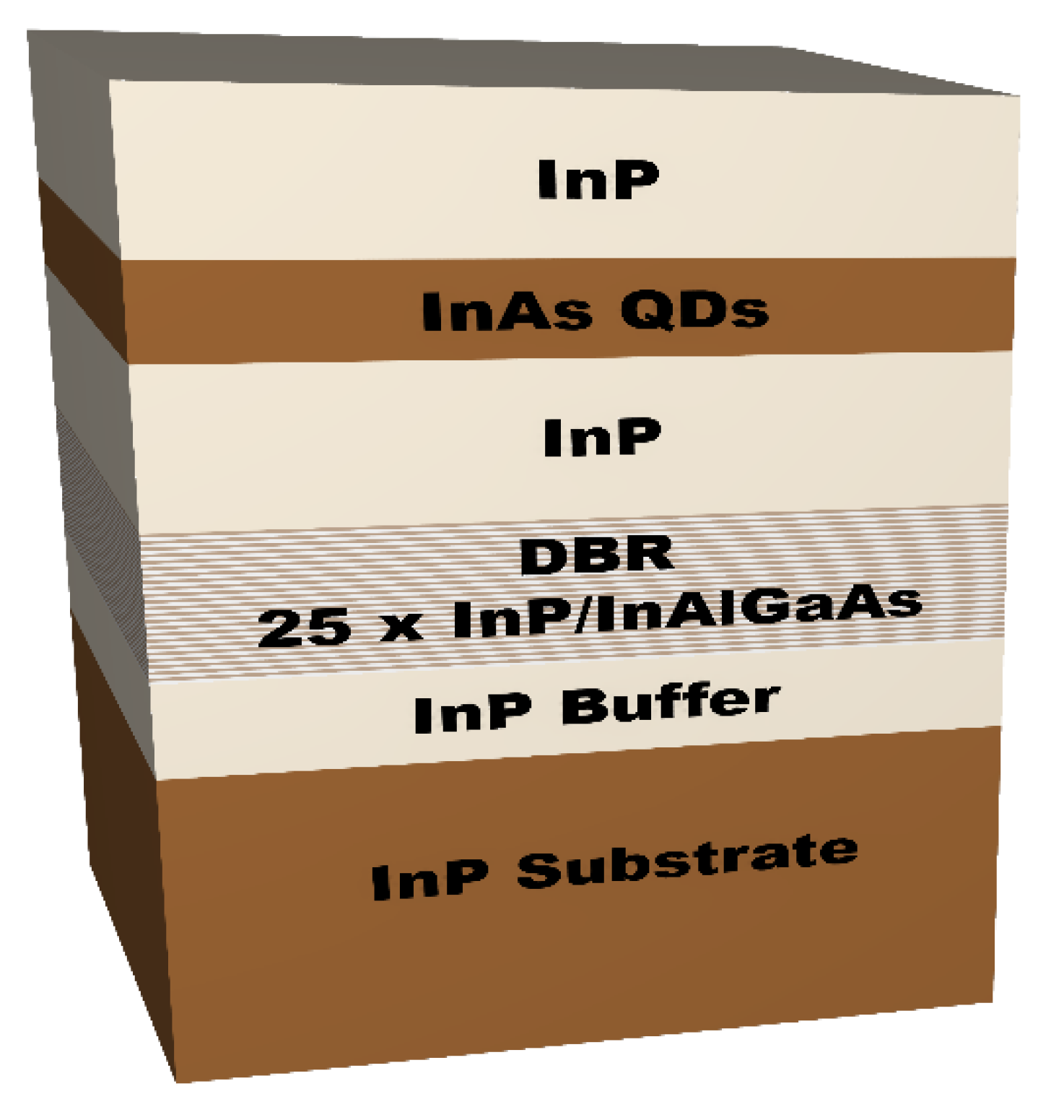
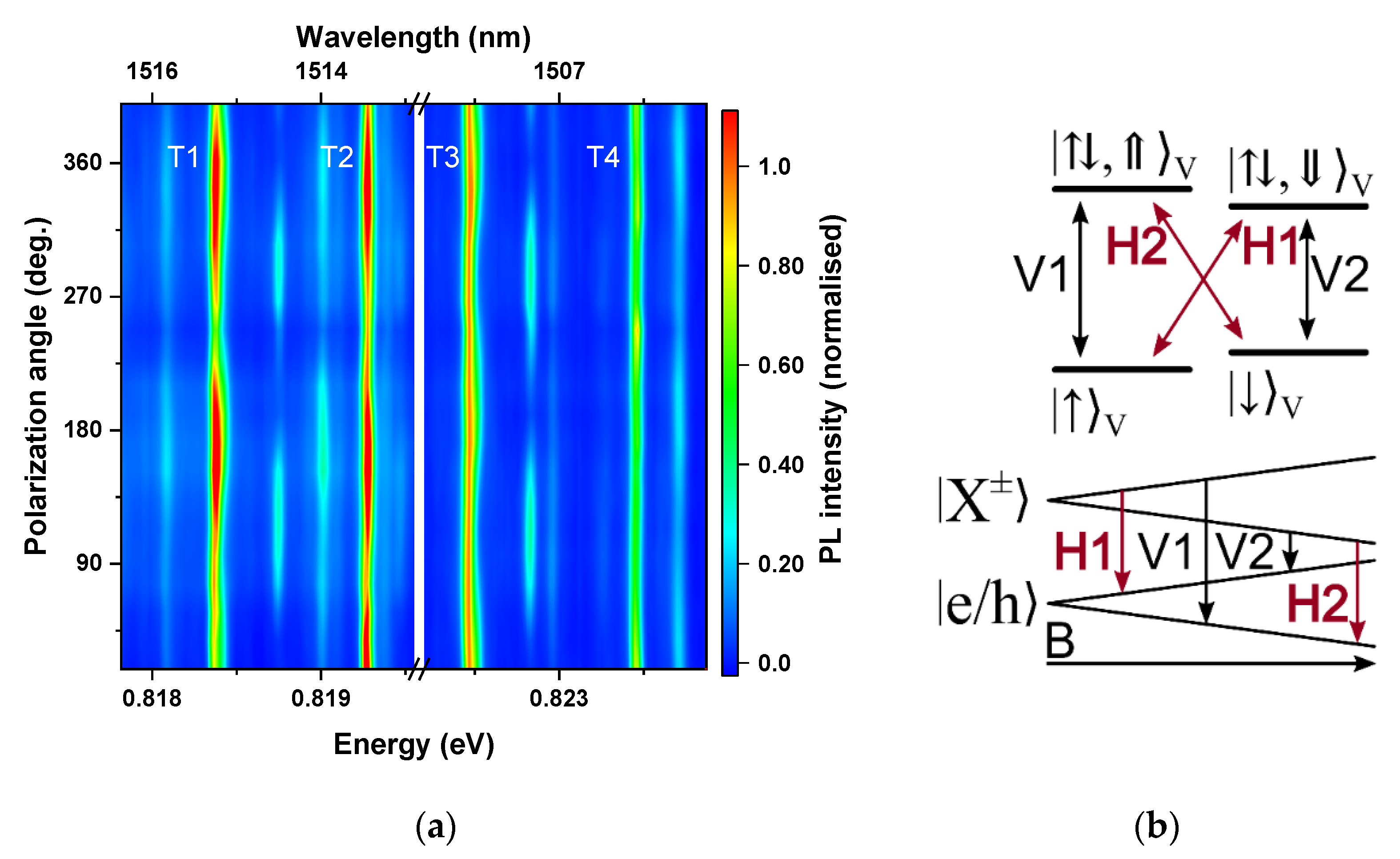
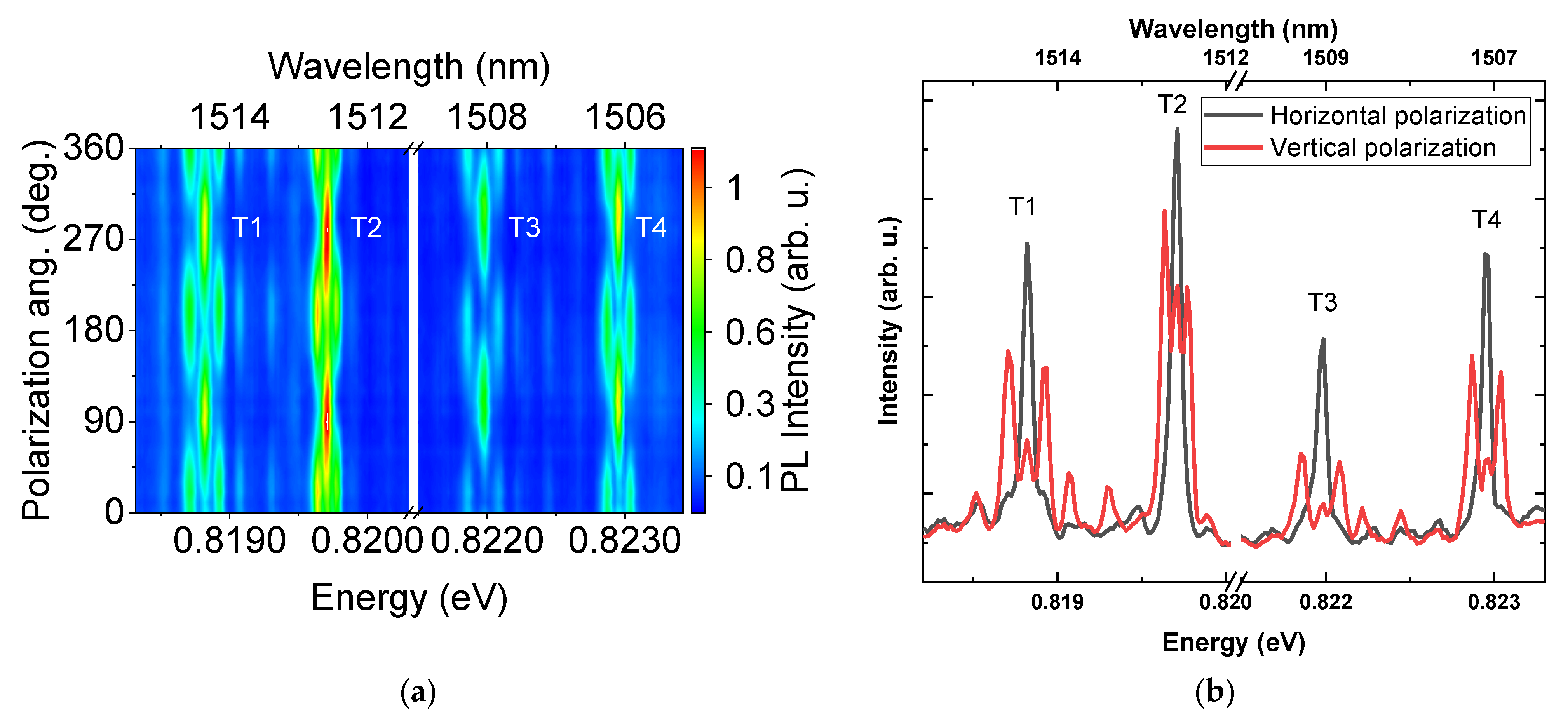
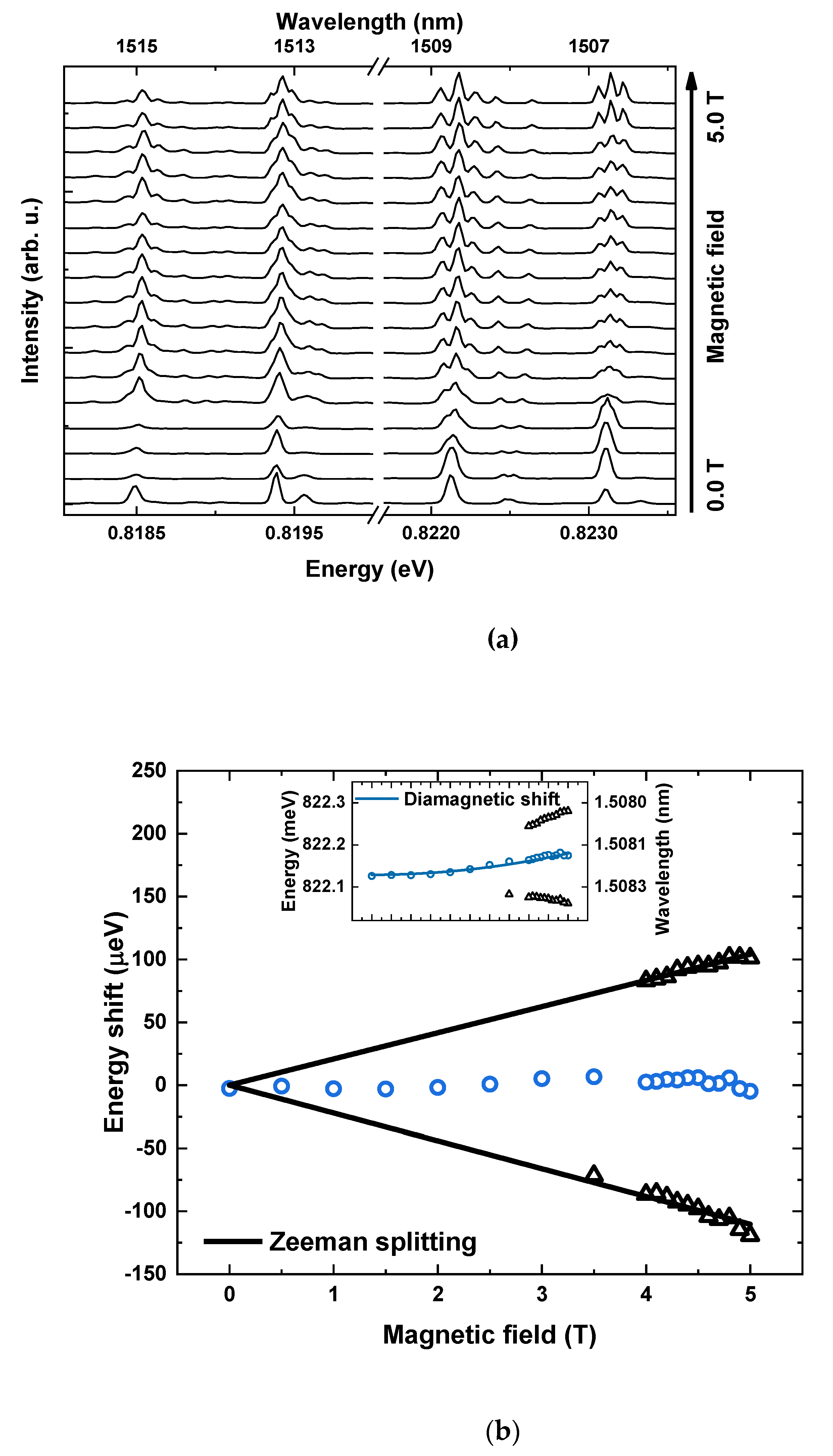
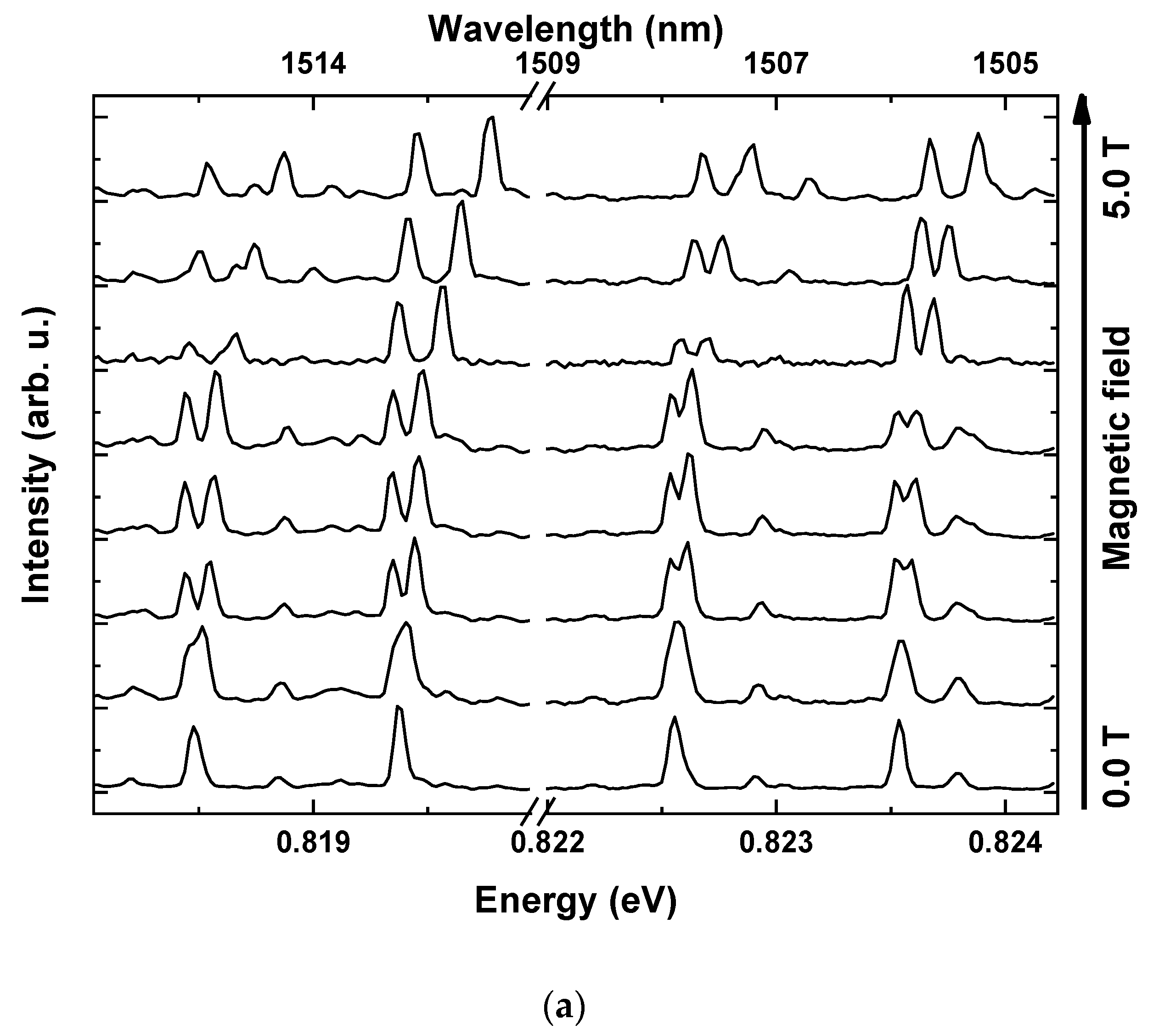
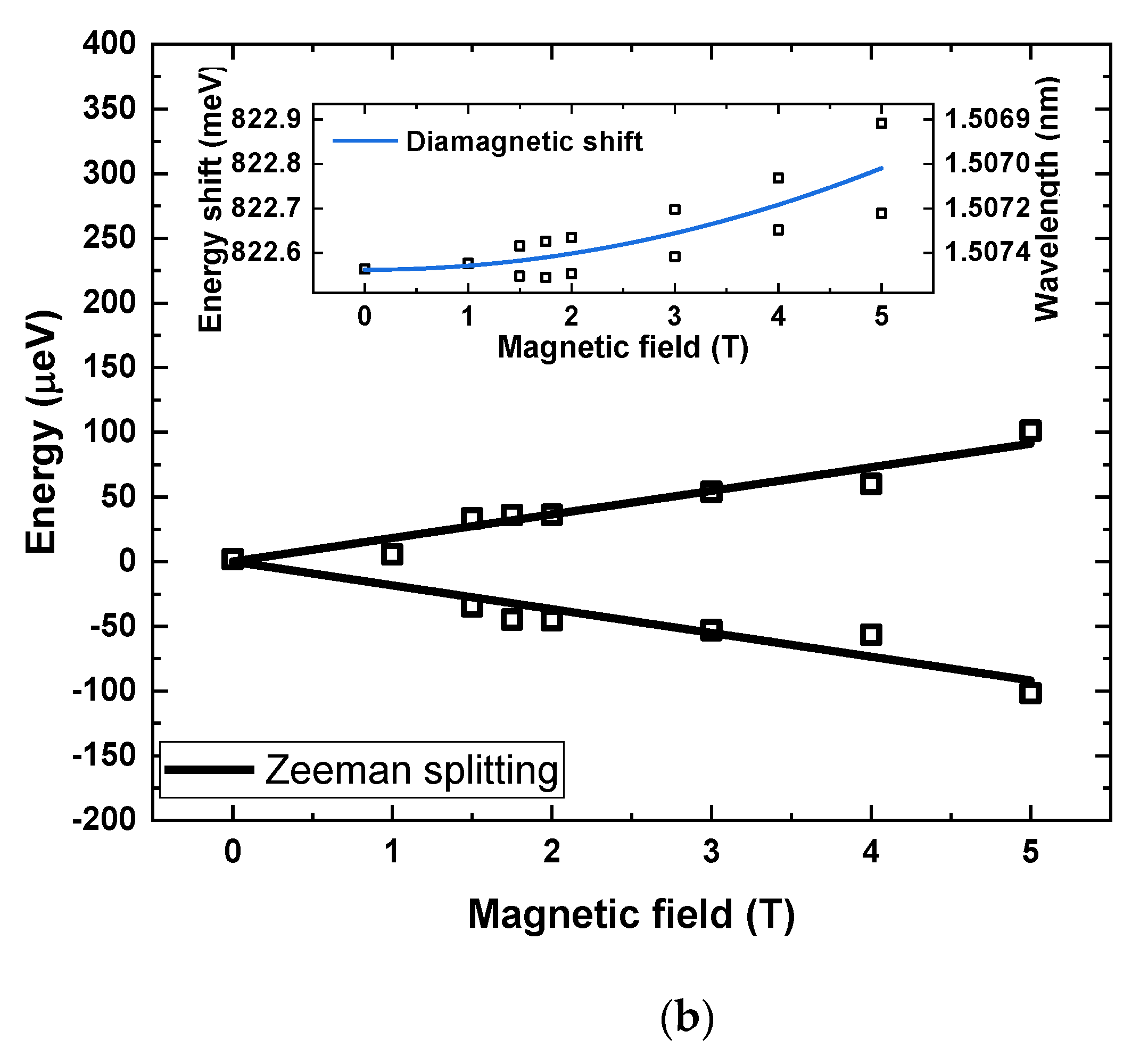
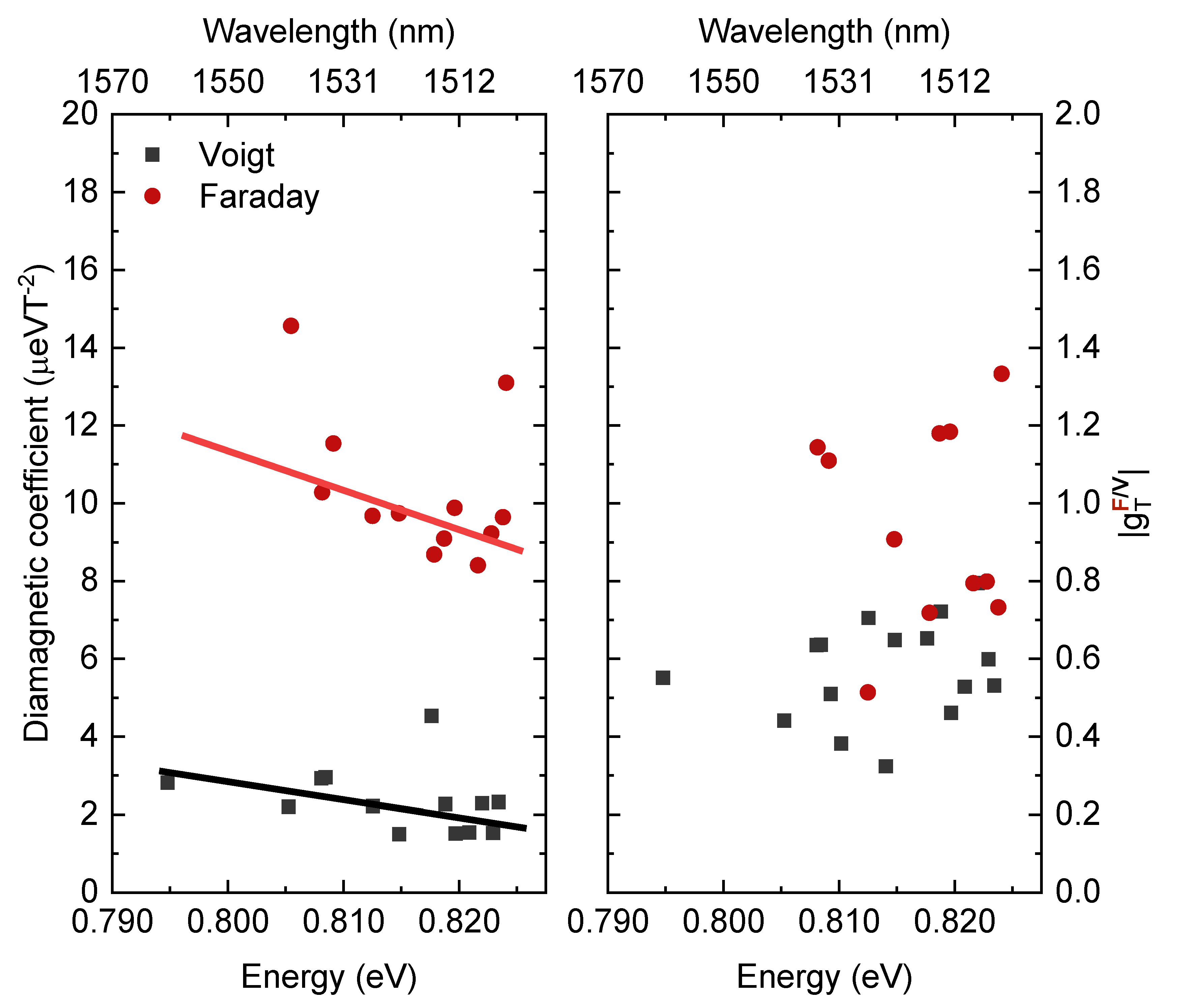
| Field Configuration | Absolute Value of g-Factor | |
|---|---|---|
| Voigt | 1.5–4 | 0.3–0.7 |
| Faraday | 8–15 | 0.5–1.3 |
Publisher’s Note: MDPI stays neutral with regard to jurisdictional claims in published maps and institutional affiliations. |
© 2021 by the authors. Licensee MDPI, Basel, Switzerland. This article is an open access article distributed under the terms and conditions of the Creative Commons Attribution (CC BY) license (http://creativecommons.org/licenses/by/4.0/).
Share and Cite
Rudno-Rudziński, W.; Burakowski, M.; Reithmaier, J.P.; Musiał, A.; Benyoucef, M. Magneto-Optical Characterization of Trions in Symmetric InP-Based Quantum Dots for Quantum Communication Applications. Materials 2021, 14, 942. https://doi.org/10.3390/ma14040942
Rudno-Rudziński W, Burakowski M, Reithmaier JP, Musiał A, Benyoucef M. Magneto-Optical Characterization of Trions in Symmetric InP-Based Quantum Dots for Quantum Communication Applications. Materials. 2021; 14(4):942. https://doi.org/10.3390/ma14040942
Chicago/Turabian StyleRudno-Rudziński, Wojciech, Marek Burakowski, Johann P. Reithmaier, Anna Musiał, and Mohamed Benyoucef. 2021. "Magneto-Optical Characterization of Trions in Symmetric InP-Based Quantum Dots for Quantum Communication Applications" Materials 14, no. 4: 942. https://doi.org/10.3390/ma14040942
APA StyleRudno-Rudziński, W., Burakowski, M., Reithmaier, J. P., Musiał, A., & Benyoucef, M. (2021). Magneto-Optical Characterization of Trions in Symmetric InP-Based Quantum Dots for Quantum Communication Applications. Materials, 14(4), 942. https://doi.org/10.3390/ma14040942






